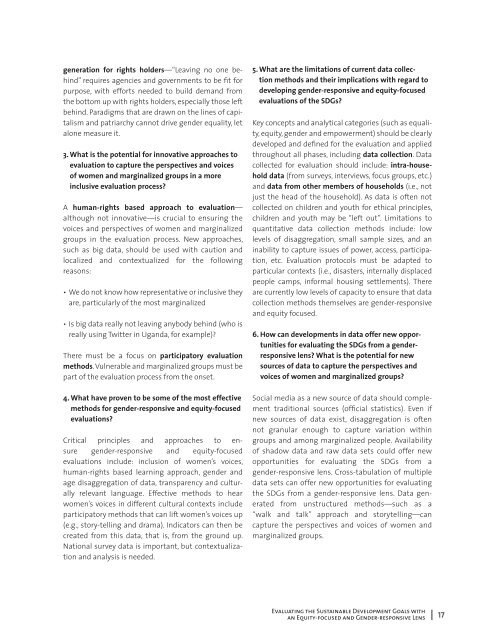NO ONE LEFT BEHIND
NY-Events-Report_WEB
NY-Events-Report_WEB
Create successful ePaper yourself
Turn your PDF publications into a flip-book with our unique Google optimized e-Paper software.
generation for rights holders—“Leaving no one behind”<br />
requires agencies and governments to be fit for<br />
purpose, with efforts needed to build demand from<br />
the bottom up with rights holders, especially those left<br />
behind. Paradigms that are drawn on the lines of capitalism<br />
and patriarchy cannot drive gender equality, let<br />
alone measure it.<br />
3. What is the potential for innovative approaches to<br />
evaluation to capture the perspectives and voices<br />
of women and marginalized groups in a more<br />
inclusive evaluation process?<br />
A human-rights based approach to evaluation—<br />
although not innovative—is crucial to ensuring the<br />
voices and perspectives of women and marginalized<br />
groups in the evaluation process. New approaches,<br />
such as big data, should be used with caution and<br />
localized and contextualized for the following<br />
reasons:<br />
••<br />
We do not know how representative or inclusive they<br />
are, particularly of the most marginalized<br />
••<br />
Is big data really not leaving anybody behind (who is<br />
really using Twitter in Uganda, for example)?<br />
There must be a focus on participatory evaluation<br />
methods. Vulnerable and marginalized groups must be<br />
part of the evaluation process from the onset.<br />
4. What have proven to be some of the most effective<br />
methods for gender-responsive and equity-focused<br />
evaluations?<br />
Critical principles and approaches to ensure<br />
gender-responsive and equity-focused<br />
evaluations include: inclusion of women’s voices,<br />
human-rights based learning approach, gender and<br />
age disaggregation of data, transparency and culturally<br />
relevant language. Effective methods to hear<br />
women’s voices in different cultural contexts include<br />
participatory methods that can lift women’s voices up<br />
(e.g., story-telling and drama). Indicators can then be<br />
created from this data, that is, from the ground up.<br />
National survey data is important, but contextualization<br />
and analysis is needed.<br />
5. What are the limitations of current data collection<br />
methods and their implications with regard to<br />
developing gender-responsive and equity-focused<br />
evaluations of the SDGs?<br />
Key concepts and analytical categories (such as equality,<br />
equity, gender and empowerment) should be clearly<br />
developed and defined for the evaluation and applied<br />
throughout all phases, including data collection. Data<br />
collected for evaluation should include: intra-household<br />
data (from surveys, interviews, focus groups, etc.)<br />
and data from other members of households (i.e., not<br />
just the head of the household). As data is often not<br />
collected on children and youth for ethical principles,<br />
children and youth may be “left out”. Limitations to<br />
quantitative data collection methods include: low<br />
levels of disaggregation, small sample sizes, and an<br />
inability to capture issues of power, access, participation,<br />
etc. Evaluation protocols must be adapted to<br />
particular contexts (i.e., disasters, internally displaced<br />
people camps, informal housing settlements). There<br />
are currently low levels of capacity to ensure that data<br />
collection methods themselves are gender-responsive<br />
and equity focused.<br />
6. How can developments in data offer new opportunities<br />
for evaluating the SDGs from a genderresponsive<br />
lens? What is the potential for new<br />
sources of data to capture the perspectives and<br />
voices of women and marginalized groups?<br />
Social media as a new source of data should complement<br />
traditional sources (official statistics). Even if<br />
new sources of data exist, disaggregation is often<br />
not granular enough to capture variation within<br />
groups and among marginalized people. Availability<br />
of shadow data and raw data sets could offer new<br />
opportunities for evaluating the SDGs from a<br />
gender-responsive lens. Cross-tabulation of multiple<br />
data sets can offer new opportunities for evaluating<br />
the SDGs from a gender-responsive lens. Data generated<br />
from unstructured methods—such as a<br />
“walk and talk” approach and storytelling—can<br />
capture the perspectives and voices of women and<br />
marginalized groups.<br />
Evaluating the Sustainable Development Goals with<br />
an Equity-focused and Gender-responsive Lens 17


